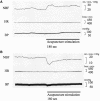Acupuncture Treatment for Low Back Pain and Lower Limb Symptoms-The Relation between Acupuncture or Electroacupuncture Stimulation and Sciatic Nerve Blood Flow
- PMID: 18604251
- PMCID: PMC2396470
- DOI: 10.1093/ecam/nem050
Acupuncture Treatment for Low Back Pain and Lower Limb Symptoms-The Relation between Acupuncture or Electroacupuncture Stimulation and Sciatic Nerve Blood Flow
Abstract
To investigate the clinical efficacy of acupuncture treatment for lumbar spinal canal stenosis and herniated lumbar disc and to clarify the mechanisms in an animal experiment that evaluated acupuncture on sciatic nerve blood flow. In the clinical trial, patients with lumbar spinal canal stenosis or herniated lumbar disc were divided into three treatment groups; (i) Ex-B2 (at the disordered level), (ii) electrical acupuncture (EA) on the pudendal nerve and (iii) EA at the nerve root. Primary outcome measurements were pain and dysesthesia [evaluated with a visual analogue scale (VAS)] and continuous walking distance. In the animal study, sciatic nerve blood flow was measured with laser-Doppler flowmetry at, before and during three kinds of stimulation (manual acupuncture on lumber muscle, electrical stimulation on the pudendal nerve and electrical stimulation on the sciatic nerve) in anesthetized rats. For the clinical trial, approximately half of the patients who received Ex-B2 revealed amelioration of the symptoms. EA on the pudendal nerve was effective for the symptoms which had not improved by Ex-B2. Considerable immediate and sustained relief was observed in patients who received EA at the nerve root. For the animal study, increase in sciatic nerve blood flow was observed in 56.9% of the trial with lumber muscle acupuncture, 100% with pudendal nerve stimulation and 100% with sciatic nerve stimulation. Sciatic nerve stimulation sustained the increase longer than pudendal nerve stimulation. One mechanism of action of acupuncture and electrical acupuncture stimulation could be that, in addition to its influence on the pain inhibitory system, it participates in causing a transient change in sciatic nerve blood blow, including circulation to the cauda equine and nerve root.
Keywords: disc herniation; pudendal nerve; sciatic nerve; spinal canal stenosis; spinal nerve root.
Figures








Similar articles
-
The effect of electrical stimulation of the pudendal nerve on sciatic nerve blood flow in animals.Acupunct Med. 2008 Sep;26(3):145-8. doi: 10.1136/aim.26.3.145. Acupunct Med. 2008. PMID: 18818560
-
Pudendal nerve electroacupuncture for lumbar spinal canal stenosis - a case series.Acupunct Med. 2008 Sep;26(3):140-4. doi: 10.1136/aim.26.3.140. Acupunct Med. 2008. PMID: 18818559
-
Spinal nerve root electroacupuncture for symptomatic treatment of lumbar spinal canal stenosis unresponsive to standard acupuncture: a prospective case series.Acupunct Med. 2012 Jun;30(2):103-8. doi: 10.1136/acupmed-2011-010122. Epub 2012 Apr 25. Acupunct Med. 2012. PMID: 22534725 Clinical Trial.
-
The diagnostic pitfalls of lumbar disc herniation---- malignant sciatic nerve tumour: two case reports and literature review.BMC Musculoskelet Disord. 2021 Oct 5;22(1):848. doi: 10.1186/s12891-021-04728-1. BMC Musculoskelet Disord. 2021. PMID: 34610793 Free PMC article. Review.
-
The Role of Acupuncture in Interventional Pain Management.Med Acupunct. 2021 Oct 1;33(5):329-334. doi: 10.1089/acu.2021.0004. Epub 2021 Oct 18. Med Acupunct. 2021. PMID: 35003500 Free PMC article. Review.
Cited by
-
Effectiveness of Acupuncture for Treating Sciatica: A Systematic Review and Meta-Analysis.Evid Based Complement Alternat Med. 2015;2015:425108. doi: 10.1155/2015/425108. Epub 2015 Oct 21. Evid Based Complement Alternat Med. 2015. PMID: 26576192 Free PMC article. Review.
-
Effectiveness and safety of acupotomy for lumbar disc herniation: a study protocol for a randomized, assessor-blinded, controlled pilot trial.Integr Med Res. 2017 Sep;6(3):310-316. doi: 10.1016/j.imr.2017.07.005. Epub 2017 Jul 24. Integr Med Res. 2017. PMID: 28951845 Free PMC article.
-
Effect of Low- and High-Frequency Auricular Stimulation with Electro-Acupuncture on Cutaneous Microcirculation: A Cross-Over Study in Healthy Subjects.Medicines (Basel). 2023 Feb 13;10(2):17. doi: 10.3390/medicines10020017. Medicines (Basel). 2023. PMID: 36827217 Free PMC article.
-
The Efficacy of Acupuncture for the Treatment of Sciatica: A Systematic Review and Meta-Analysis.Evid Based Complement Alternat Med. 2015;2015:192808. doi: 10.1155/2015/192808. Epub 2015 Sep 6. Evid Based Complement Alternat Med. 2015. PMID: 26425130 Free PMC article. Review.
-
Umbilical acupuncture combined with warm needle acupuncture for the treatment of residual numbness after lumbar disc herniation surgery: a protocol of a randomized controlled trial.Front Neurol. 2025 Mar 11;16:1528411. doi: 10.3389/fneur.2025.1528411. eCollection 2025. Front Neurol. 2025. PMID: 40134699 Free PMC article.
References
-
- Rydevik B, Brown MD, Lundborg G. Pathoanatomy and pathophysiology of nerve root compression. Spine. 1984;9:7–15. - PubMed
-
- Inoue M. Developing a new acupuncture treatment for stenosis in the lumbar part of spinal cord: A basic, clinical review. Japan J Acupunc Manual Therapies. 2003;62:40–6. (in Japanese)
-
- Yano T, Inoue M. Effect of acupuncture stimulation on blood flow in the nerve trunk. Auton Nerv Syst. 2006;43:348–56.
-
- Inoue M, Hojo T, Katayama K, Yano T, Katsumi Y. Application of electrical acupuncture at lumbar nerve root as treatment of sciatica due to radiculopathy. Bull Meiji Univ Orient Med. 2002;30:1–8. (in Japanese)
-
- Inoue M, Hojo T, Yano T, Katsumi Y. Electroacupuncture direct to spinal nerves as an alternative to selective spinal nerve block in patients with radicular sciatica – a cohort study. Acupunct Med. 2005;23:27–30. - PubMed
LinkOut - more resources
Full Text Sources
Other Literature Sources

